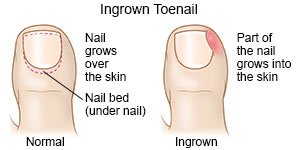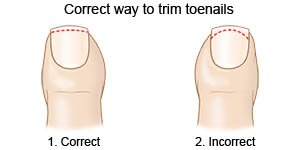Partial Nail Avulsion for Ingrown Nail
Medically reviewed by Drugs.com. Last updated on Apr 6, 2025.
A partial nail avulsion is a procedure to remove an ingrown nail. An ingrown nail is when the edge of your fingernail or toenail grows into the skin next to it.
 |
DISCHARGE INSTRUCTIONS:
Seek care immediately if:
- Blood soaks through your bandage.
- You have a red streak running up your leg or arm.
Call your doctor if:
- You have a fever or chills.
- Your wound is red, swollen, or draining pus.
- Your pain is getting worse.
- Your symptoms return.
- The nail is not better in 7 days.
- You have questions or concerns about your condition or care.
Medicines:
- Acetaminophen decreases pain and fever. It is available without a doctor's order. Ask how much to take and how often to take it. Follow directions. Acetaminophen can cause liver damage if not taken correctly.
- NSAIDs , such as ibuprofen, help decrease swelling, pain, and fever. This medicine is available with or without a doctor's order. NSAIDs can cause stomach bleeding or kidney problems in certain people. If you take blood thinner medicine, always ask your healthcare provider if NSAIDs are safe for you. Always read the medicine label and follow directions.
- Take your medicine as directed. Contact your healthcare provider if you think your medicine is not helping or if you have side effects. Tell your provider if you are allergic to any medicine. Keep a list of the medicines, vitamins, and herbs you take. Include the amounts, and when and why you take them. Bring the list or the pill bottles to follow-up visits. Carry your medicine list with you in case of an emergency.
Self-care:
- Soak your wound in warm water 2 times a day. Look for signs of infection such as redness, swelling, or drainage. It may take up to 4 weeks to heal.
- Keep your nail area clean, dry, and covered. Put on a clean, new bandage as directed. Do not use an adhesive bandage. It may stick to the wound and cause pain when you remove it. Ask your healthcare provider what kind of bandage to use. Change your bandage when it gets wet or dirty.
- Wear tennis shoes or shoes that fit loosely for the first 2 weeks. Do not wear tight shoes or shoes with high heels. Do not run or do strenuous activity for 2 to 4 weeks.
- Elevate your hand or foot above the level of your heart as often as you can for 24 hours. This will help decrease swelling and pain. Prop your hand or foot on pillows or blankets to keep it elevated comfortably.
- Ask when you can return to work, school, or your usual sports and activities.
Prevent another ingrown nail:
- Trim your nails straight across. Do not cut them too short. Do not tear your nails at the corners or pick at them. Lightly file the nail corners if you have sharp edges. Do not round your nails. Use clippers, not nail scissors.

- Keep your nails clean and dry. Wash your hands and feet with soap and water. Pat dry with a clean towel. Dry in between each toe. Do not put lotion between your toes.
- Inspect your nails daily. Look for signs of an ingrown nail. Manage problems early so the nail does not become infected.
Follow up with your doctor as directed:
Write down your questions so you remember to ask them during your visits.
© Copyright Merative 2025 Information is for End User's use only and may not be sold, redistributed or otherwise used for commercial purposes.
The above information is an educational aid only. It is not intended as medical advice for individual conditions or treatments. Talk to your doctor, nurse or pharmacist before following any medical regimen to see if it is safe and effective for you.
Learn more about Partial Nail Avulsion for Ingrown Nail
Care guides
Further information
Always consult your healthcare provider to ensure the information displayed on this page applies to your personal circumstances.
